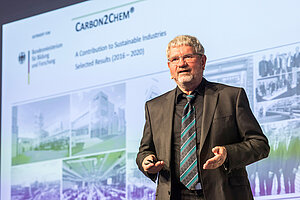The chances of reducing industrial CO2 emissions by 2030 are good. The technical prerequisites have been created thanks to projects such as Carbon2Chem®. Now it is important to set up the corresponding framework conditions in the form of regulations, renewable energies and green hydrogen. This is the quintessence of the 3rd Conference on Sustainable Chemical Conversion on October 27 and 28, 2020.
The event brought together representatives from politics, business and science to discuss the requirements and options for a climate-friendly industry. Occasion: The first phase of the joint project Carbon2Chem® funded by the German Federal Ministry of Education and Research (BMBF) was successfully completed. Coordinated by the Max Planck Institute for Chemical Energy Conversion, the Fraunhofer Institute for Environmental, Safety, and Energy Technology UMSICHT and thyssenkrupp, over the past four years process concepts have been developed which allow CO2-containing waste gases from Germany's biggest steel mill in Duisburg to be captured, cleaned and converted into basic materials for chemicals, fuels or fertilizers using "green" hydrogen.
Voices from politics
The conference focused on the classification of these results and the political course for their implementation. In her welcoming address, Federal Research Minister Anja Karliczek emphasized: "With the Green Deal we want to make Europe the first climate-neutral continent. This is no less than a fifth industrial revolution. Carbon2Chem® is a showcase example of how we can make the Green Deal a reality – and why we should definitely do so. Because the innovations from Carbon2Chem® not only protect the climate – they also strengthen our long-term competitiveness and secure high-quality jobs in the industry."
Please find further information in the press release.

